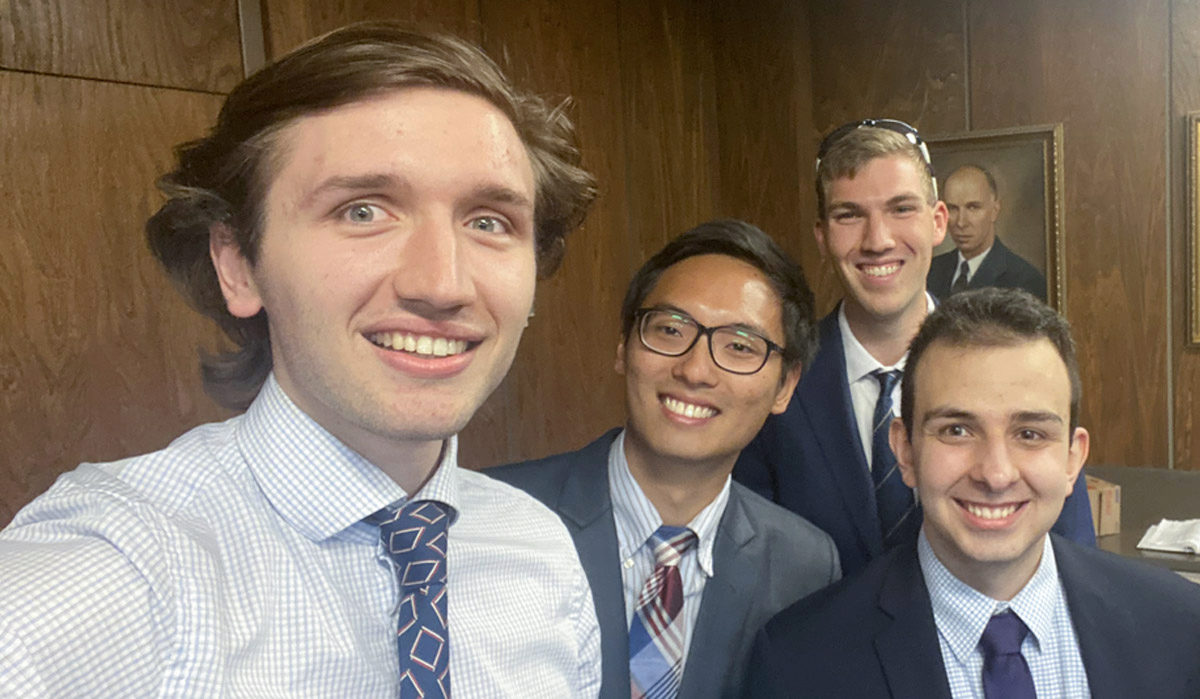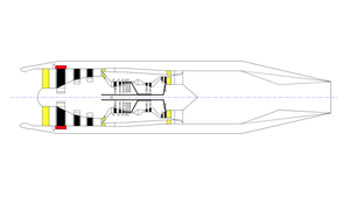 It Takes a Team. Celebrating the submission of their work are, from left, Steve Zakharov, Soon Keat Ong, Oscar Klempay, and Ted Vlady. Photo taken prior to social distancing protocols.
It Takes a Team. Celebrating the submission of their work are, from left, Steve Zakharov, Soon Keat Ong, Oscar Klempay, and Ted Vlady. Photo taken prior to social distancing protocols.
Four undergraduates from the Daniel Guggenheim School of Aerospace Engineering - Steve Zakharov, Soon Keat Ong, Oscar Klempay, and Ted Vlady - were recognized last month by the American Institute for Aeronautics & Astronautics (AIAA) for their design of a supersonic business jet.
 |
| The YJ-2030 engine includes a mixed flow turbofan with mixer ejector nozzle. |
The team's paper, "YJ-2030: Candidate Engine for a Supersonic Business Jet" took first place (and a $1,000 prize) in the 2020 Aerospace Power Student Paper Competition, which held a virtual competition during the AIAA 2020 Propulsion Energy Forum.
Team advisor, Prof. Jerry Seitzman, was quick to heap praise on the students, who submitted the paper just after COVID 19 shut down the AE School campus in April. They attended the AIAA Forum's competition in August using video-conferencing software.
"It was great to see Ted, Oscar, Soon and Steve getting recognition for all the hard work and creativity they put into their engine design. They embody the best we expect of Georgia Tech students: technical excellence, resourcefulness, passion and professionalism," he said.
"They put together an outstanding technical proposal to pass the first round of the competition, and then won the second round by effectively communicating and defending their design to a live panel of judges in a challenging virtual forum".
The 2020 competition challenged teams to design a jet engine for use on a supersonic business jet that cruises at Mach 2.1, with a maximum speed of Mach 3.0, able to travel from Europe to North America and back, in one day, carrying a maximum of twelve passengers.
According to team lead Vlady, the group designed a mixed flow afterburning turbofan engine, named "YJ-2030" (YJ for "Yellow Jacket", of course).
"The majority of our work focused on the design of the engine thermodynamic cycle and the design of the specific engine components like the inlet, compressors, combustor, turbines, and exhaust systems," explained Vlady.
"The exhaust system architecture that we chose is typically used on military jet engines, so any step-by-step design information is classified or proprietary."
But that didn't stop them from being resourceful.
"We opted to try and extrapolate the few studies done by NASA and fit them to our engine. Then, we validated our results by comparing our design to the basic cross sections of military engines that are publicly available".
That design, combined with a confident virtual presentation, was the winning combination.
"Presenting virtually made it very difficult for us to gauge how the audience was understanding our designs," Vlady shared.
The team overcame this challenge by taking a different approach to their presentation.
"We decided to include more sentences and diagrams in our presentation that we would have if we were in person. This allowed the judges and audience to still read and understand our presentations even if we were having audio issues".
Vlady shared his gratitude for the support the AE school provided him and his teammates.
"Our team’s success wouldn’t have been possible without our great advisors Prof. Dr. Jerry Seitzman and Mr. Russ Denney from the Aerospace Systems Design Lab (ASDL)".